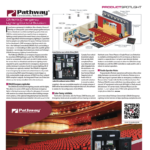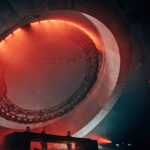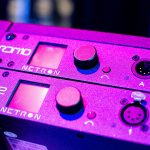The Martin MAC 2000 line of luminaires is arguably the most successful series of moving lights sold to date. It is almost impossible to accurately predict what combination of features, reliability and cost makes up the perfect product. Chalk it up to a whole lot of skill and at least a little bit of luck. Possibly the only thing harder than building a revolutionary product is doing it again. With this in mind, the engineers in Denmark went back to the drafting table to create what would become the little brother to the MAC 2000.
700 Watts with a 1200-Watt Look
The MAC 700 Profile is a moving-head spot luminaire weighing in at just over 76 pounds. Its 16-bit stepper motor movement offers 246 degrees and 540 degrees, respectively, of auto-correcting tilt and pan positioning.
Many of the details on the fixture can be found in its brethren. The MAC tilt locks, LED addressing display and clamp mounts are not noticeably different from the MAC 2000 lights. In fact, from a distance, the fixtures appear almost identical, if you discount the difference in size.
The fixture makes use of a double-ended 700-watt short arc lamp, either the Osram HTI 700/D4/75 or the Philips MSR 700 SA/2 DE. The factory-standard electronic ballast offers hot re-strike and reduced-power options, while temperature sensors in the head and base control fan speed to minimize noise. The unit can be powered on worldwide voltages with the change of a single fuse.
An optical diffuser comes pre-installed that helps eliminate aberrations in the beam which can be caused by the dimming and color mixing flags at low intensity levels. With the diffuser installed, the fixture has a maximum output of 14,700 lumens. If low-intensity beam patterning is not an issue, the diffuser can be removed to yield a maximum output of 16,700 lumens, roughly a 10% gain.
Full-range dimming is provided via a pair of dimming flags, which do double-duty as strobe flags as well. Because the travel distance for the flags is very short, they can move quickly, achieving strobe rates from 2 Hz to 10 Hz.
Motorized zoom and focus functions make fixture placement incredibly versatile. The optical zoom offers a range from 14 to 30 degrees, while the focus mechanism allows for a sharp focus from two meters to infinity at any zoom angle. The fixture is also very modular; you can remove the cover on the head with four quarter-turn screws and the modular components like the color and gobo modules can be removed without any tools.
Textures, Effects and Animation
Having become one of the most popular features of the MAC 2000 Performance fixture, a gobo animation wheel is the feature that will most likely set the MAC 700 Profile apart from the others in the field. The interchangeable effect can be indexed or set in constant motion, adding a layer of movement to the fixture’s graphics that breaks away from the rotating gobos that have become de rigueur. It can also orient the animation wheel between 0 and 90° so that the effect moves vertically, horizontally, or anywhere in between.
Two standard gobo wheels are included in the fixture. The first wheel allows continuous and indexed rotation of patterns with six glass, textured glass and metal gobos, plus an open position. The second wheel includes nine static metal patterns plus an open position. The optics are designed to allow morphing effects between the two gobo wheels.
Other beam effects can be achieved via a rotating three-facet prism and a separate motorized iris. Both functions operate independently of other on-board parameters, allowing for layering with any other effects.
A CMY color-mixing engine comes standard along with an eight-position (plus open) color wheel. The cyan, magenta and yellow color mixing system consists of a pair of shorttravel flags for each color, allowing quick and accurate color changes. The color wheel offers interchangeable color filters in each slot.
Dual Personalities
The fixture is controlled via a DMX-512 lighting console or control device. It includes three-pin and five-pin locking XLR data ports for easy integration into any lighting system, with the internal receiver opto-isolated for added signal integrity.
Two fixture personalities are currently available, using 23 and 31 DMX channels respectively. All of the base functionality is available in either fixture mode, with the second personality offering higher resolution 16-bit adjustment for eight of the parameters. These include dimming, cyan, magenta, yellow, color wheel, iris, focus and zoom functions. It’s worth noting that some fixtures sacrifice 16-bit positioning in reduced channel-count modes; not so here.
The MAC Attack
With these fixtures already popping up around the world, it is likely that Martin has come up with another winner. Offering many of the features that have made the MAC 2000 series famous, the MAC 700 Profile should allow a wider cross-section of the market to get their hands on a MAC.
Phil Gilbert is a freelance lighting designer and programmer. You can contact him by e-mail at pgilbert@ plsn.com or via his Web site at www.philgilbert.net.


